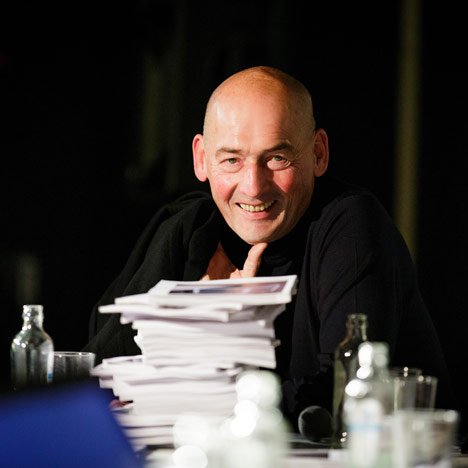
De Rotterdam represents "a new ambition in architecture" says Rem Koolhaas
At the launch of his giant De Rotterdam building last week, architect Rem Koolhaas discussed his home city and his latest contribution to it. "This building is not the same from any angle," he said. "We consider that not so much an innovation but a new ambition in architecture" (+ transcript).
Described by OMA as a vertical city, the 150-metre building combines a hotel, offices and apartments within a grouping of glazed towers. It is positioned on the south bank of the Maas river in Rotterdam - a district that Koolhaas says became a "ghost town" after harbour activities moved away from the city centre in the 1980s and 90s.
"The reason that the De Rotterdam building is where it is, is simply because it became important for the city to project the next phase of its existence and to undo the ghost town," he told journalists during a tour of OMA's Rotterdam office. "This is not simply architectural ambition, but part of the ambition of the city."
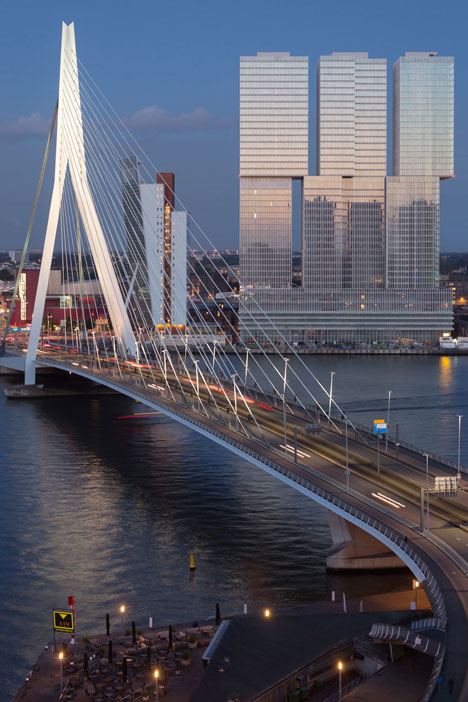
The building is made up of shifted volumes that share a single plinth, though Koolhaas said the original brief was for two separate structures. "We thought this degree of separation would lead to a very fragmented urban condition, so our idea was to have a base that combines these two operations," he explained.
"As you move to different parts of the city, the building suggests a new identity or different identities," he added. "I think it's boring if a single building is the same from every angle."
The architect revealed that the financial crisis of 2008 helped the building to be realised, following a series of funding issues and programme changes.
"The irony is that because of the last crisis, the building prices came down and it actually became possible to work with German contractors for the first time in the Netherlands," he explained. "So the first crisis almost killed the project but the second crisis revived it."
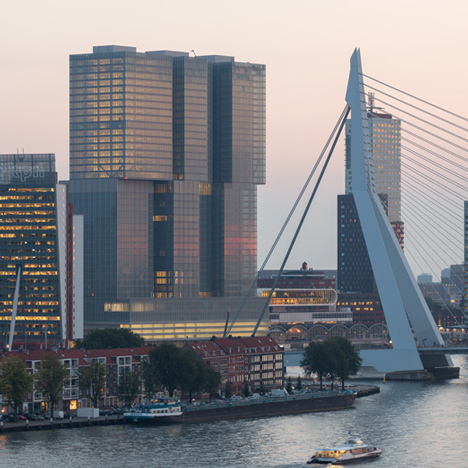
Koolhaas also discussed the post-war history of Rotterdam and his ideas about "Bigness" that informed the De Rotterdam project.
"There are ways - like how the Surrealists were able to combine an umbrella and a sewing machine in the same picture - that architecture can experiment with contrasts," he said. "Rotterdam is a city where experimentation is very legitimate because it was entirely destroyed [during the war], so the whole idea of context is very relative here."
See more images of the project in our earlier story or watch a video interview we filmed with Koolhaas during the launch.
Below is an edited transcript of what Koolhaas had to say about the project and the city:
"The main thing to understand about Rotterdam is that it was a city that was destroyed in the beginning of the war, therefore it is a very interesting city. The city was almost completely gone and only a few buildings were left. Of course it had to be rebuilt, which is why it is a very interesting subject for architects to work on. It is no coincidence that the vast majority of architects in the Netherlands live here.
"Although of course, we are not the first wave of architects, we are more like the seventh wave of architects that are operating here. The first wave was a very heroic group of architects, hardcore modernists who basically built slabs everywhere. By the 1960s, the city was back on its feet and had a very structured centre. The centre was mostly slabs, with some department buildings and some connected shopping tissue. When I was a child, Rotterdam was a kind of global example, so there were many excursions from developing countries to see what the future would look like.
"During the 1970s, people got nervous about modernity and wanted something more interesting. Everything became very small and humanistic, and nostalgia started to play a big role. That period came and went, and at that point all the harbour activity that was here started to withdraw and increasingly moved to the sea.
"By the 80s and 90s the city was no longer facing a busy harbour, but empty warehouses; it became a kind of ghost town. So the reason that the De Rotterdam building is where it is, is simply because it became important for the city to project the next phase of its existence and to undo the ghost town.
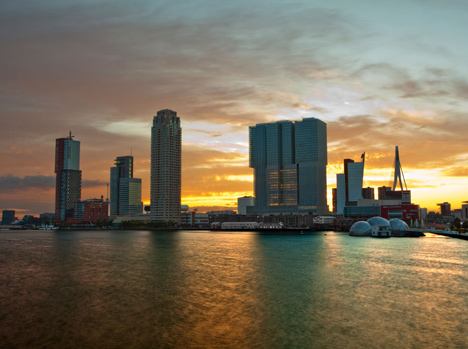
"A plan was launched in the late 80s to shift the south [of the city] to the other side of the river and it has been developed over time. It's quite complicated in terms of scale and preparing the ground, but for the first time, there is a kind of critical mass there to justify this notion that the city could have this south side.
"So this is not simply architectural ambition, but part of the ambition of the city. I personally think it is very important that ambitions are not changed every four years, not just when political regimes change or when fashions change. To maintain a degree of consistency in urbanism is important.
"I can tell you a strange anecdote. In the late 70s in Amsterdam there was a kind of notorious project that was based on hexagons, the so-called Bijlmermeer [a housing development in Amsterdam]. In the late 90s, people started to criticise the inhumane conditions there. Then an Isreali 747 crashed into one of the slabs and then slowly but surely, people started to take it down and replace it with regular housing. Now we have a situation that regular housing is becoming unpopular, and that for preservation and cultural heritage some of these kinds of structures are being resurrected. It really shows the cycle of discredit. Credit is so fast that if you follow it, you simply cannot make a city any more.
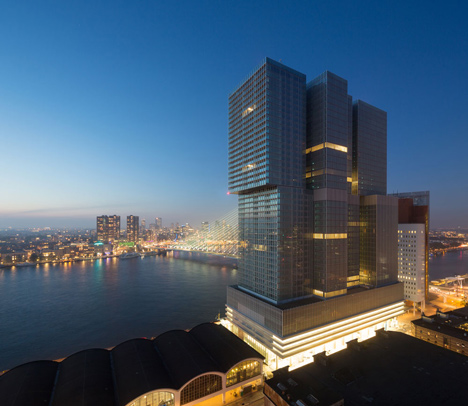
"So what we did with De Rotterdam, we started in the late 90s. It's a building for developers, as by the late 90s the public sector simply didn't have the money to realise this kind of vision, so they were collaborating with the private sector.
"We originally started with two sites and on both sites there was supposed to be a tower. When we started, we thought this degree of separation would lead to a very fragmented urban condition, so our idea was to have a base that combines these two operations.
"It was always clear that there would be housing, offices and a hotel, and all the facilities, but it was never quite clear in what proportion each element would be. We were thinking that flexibility was important for the project. In the end, what we did was develop a system where each of these elements could be shifted and could be changed and replaced with any of the other elements. So in a way its a diagram that shows, more or less, infinite flexibility in terms of programme.
"The building will always be perceived according to a single route or a single journey because - and this is the beautiful thing - it is on the other side of the river. The only way to get there is a single bridge. This means the way the building is perceived is predictable and therefore the design itself can explore that. So from far away it seems like a single mass, but as you get closer you realise its transparent and if you come closer again it becomes an oblique shape.
"The overall effect we tried to achieve was that as you move to different parts of the city, the building also suggests a new identity or different identities. I think it's boring if a single building is the same from every angle. That is almost inevitable for skyscrapers. But this building is not the same from any angle, and perhaps this is the case even more with CCTV [the China Central Television Headquarters in Beijing]. We consider that not so much an innovation, but really a new ambition in architecture. It reaches every part of the city in a new way, with this changeable identity.
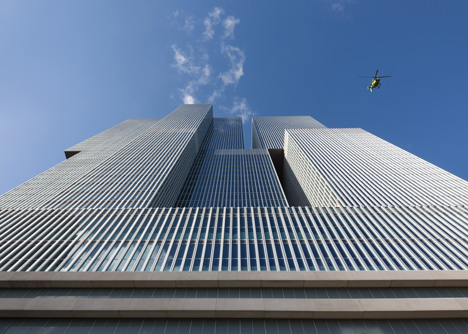
"In 1994 I wrote a piece called Bigness that explored the way in which architecture, beyond a certain scale, begins to respond to and is defined by different rules. In that essay, which really was addressed to Europeans, I suggested that contextualism was an important feature in debate. The interpretation of contextualism was that if you do a building in an environment with other buildings, the correct way is to do a building that is similar to the other buildings. Similar in scale and, if possible, similar in terms of expression.
"I was actually thinking that this was a very limiting way of thinking about it and that there is also another approach, which is to contrast. There are ways - like how the Surrealists were able to combine an umbrella and a sewing machine in the same picture - that architecture can experiment with those contrasts.
"Now Rotterdam is a city where that kind of experimentation is very legitimate because it was entirely destroyed, so the whole idea of context is very relative here. The city from the beginning was an experimental condition where you could experiment with those kind of things. This also explains why this building is cut into parts. The height relates to the taller elements, but the cut allows it to also relate to the lower elements. So the elements accommodates these two scales.
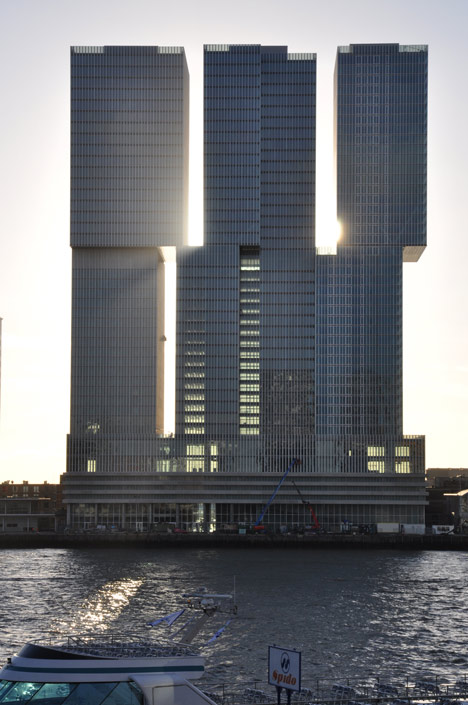
"We started [working on the project] in 1998, but in 2001 there was 9/11 and that created a downward spiral. Then there was [the recession of] 2008, so we barely had moments when we were sure that it would happen. But the irony is that because of the last crisis, the building prices came down and it actually became possible to work with German contractors for the first time in the Netherlands. So the first crisis almost killed the project but the second crisis revived it.
"Initially there was much more articulation. You could see housing, you could see hotels, but then almost all architecture had articulation so we decided that we were confident in the sculpture of the building, simply by treating it as an object rather than a building. In reality, that is what it is like; it is not part of the world of architecture.
"Journalists think that architects today can be wilful or playful but the pressure we work under is really extreme. I'm not complaining about it, but the idea that we can do what we want is deeply misplaced in whatever country or environment."